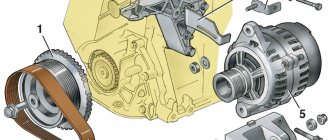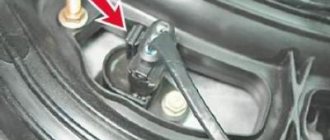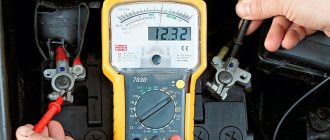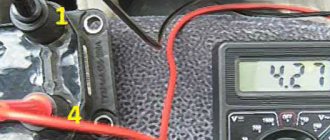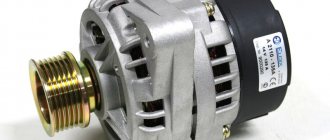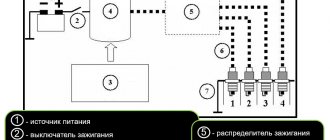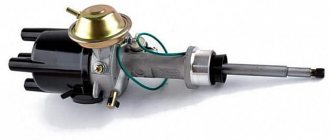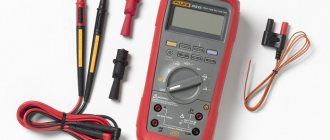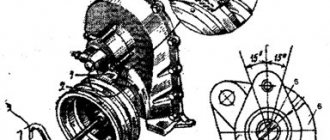Ignition coil - types, how it works, malfunctions, how to check
The ignition coil is part of the vehicle's ignition system. It converts the 12 volt battery voltage to high voltage to create a spark in the spark plug. The spark ignites the air-fuel mixture in the engine cylinders.
Most modern cars have an individual (plug) ignition coil per cylinder. Usually it is installed directly above the spark plug, as on this VAZ engine in the photo.
In some vehicles, the ignition coils for all cylinders are combined into one coil pack. In older cars with a distributor (distributor), one coil is used for all cylinders. Check out this example of an engine with a single ignition coil:
- Device
- Types of ignition coils
- Ignition coil malfunctions
- Precautionary measures
- How to check the ignition coil
- Replacing the ignition coil
Purpose of the ignition coil
Ignition of the fuel-air mixture in the combustion chamber of a gasoline engine is carried out using an electric spark generated by a spark plug. However, it is quite difficult to create a spark of sufficient strength, because gasoline mixed with air is a good dielectric, and it is not easy for even a short spark breakdown to occur in it. The problem can be solved only by applying a powerful electric pulse with a voltage of tens of thousands of volts to the spark plug. Where can you get that kind of voltage in a car, even for a short fraction of a second?
This problem is solved using a special device - an ignition coil, or bobbin. An ignition coil is a component of a vehicle's ignition system that converts low-voltage direct current (6, 12, or 24 volts depending on vehicle type) from the battery or alternator into a short electrical pulse of up to 35,000 volts. The pulse from the coil is supplied to the spark plug, a spark appears in its spark gap, which achieves the goal - ignition of the fuel-air mixture.
Today, ignition coils are used in almost all cars with gasoline engines or gas-powered engines. Reels are used with equal success both in ignition systems of traditional circuits (contact with a distributor, contactless with thyristors) and in modern electronic ignition systems. Because there is no simpler, more reliable and efficient way to create a high-voltage electrical pulse.
Ignition coil GAZ-3302 EURO-3 (module) BOSCH
Ignition coil ZMZ-40524 EURO-3 for SOATE spark plug
Ignition coil GAZ, UAZ ZMZ-405,409 EURO-5 for SOATE spark plug
Ignition coil VW Amarok,Eos,Golf,Passat AUDI A3,A4,A5,TT SKODA Octavia BOSCH
Ignition coil ZMZ-406,VAZ-1111 ATE-1
Ignition coil GAZ-24, UAZ, GAZ-3307 SOATE
Ignition coil CHEVROLET Aveo (09-) (1.4 101 hp),Cruze (1.8) ERA
Ignition coil ZMZ-406 SOATE
Ignition coil VAZ-2115 (module) SOATE
Ignition coil ZMZ-406,VAZ-1111 ATE-1
Device
The ignition coil is a transformer with two windings - primary and secondary. There is a steel core inside the windings, and an insulated casing outside.
12 volts are supplied to the primary winding. It is wound with thick copper wire and has 100–150 turns. The secondary winding is located outside the primary. It has 15,000–30,000 turns of fine copper wire.
A pulse voltage of up to 45,000 volts is induced in the secondary winding, which is supplied to the spark plugs.
This device is typical for both the ignition module, a dual-type ignition coil, and an individual coil.
Design features and principle of operation of the ignition coil
So, we immediately note that the high-voltage voltage arising in the coil, causing a spark between the electrodes of the spark plug, ensures the ignition of the fuel-air mixture in the cylinders of the internal combustion engine. At the same time, by following the rules of operation and maintenance of the ignition coil, you can increase not only its service life, but also avoid unwanted breakdowns.
At its core, the coil device is a transformer with two windings (primary and secondary). There is an iron core inside the windings, and an insulated casing outside.
Ignition coil diagram and its main components:
- frame;
- insulator, insulating paper;
- primary, secondary windings and insulation between them;
- central terminal and its spring;
- terminals of the primary winding output and terminal of the secondary winding;
- core;
- frame of the secondary winding and external insulation of the primary winding;
- external magnetic circuit;
- wires to the ignition coil;
- primary winding - from 100 to 150 turns of thick copper wire (there are two 12 Volt terminals on the ignition coil cover);
- secondary winding - from 15,000 to 30,000 turns of thin copper wire (pulse voltage supplied to the spark plugs up to 35,000 Volts).
The operation of the ignition coil is similar to the operation of the transformer and is as follows:
- the applied voltage to the primary winding circuit creates a magnetic field in the coil;
- then generation and self-induction of voltage occurs through the secondary winding of the coil due to the thickness and number of turns of the wire;
- Through the central terminal of the coil, with the help of a distribution device, the converted voltage is output to the spark plugs.
Please note that the high voltage discharge continues until the energy created by the ignition coil is spent (the remaining energy is used for damped voltage and current fluctuations).
The main types of coils are also distinguished. There are several options: individual, common (non-contact ignition coil) and dual. Each of them has its own design and connection diagram.
- Common ignition coils are used in electronic distributor ignition, contactless and contact ignition systems. The body of the device can be made of aluminum or sheet steel, the core of the device, on which the insulating tube is mounted (the secondary element is installed on top), is made of electrical steel plates insulated relative to each other. The duration of the phases during spark discharge is up to one and a half seconds, and the operating energy value is from 15 to 20 mJ;
- Individual ignition coils are used in direct electronic ignition systems. The coil is mounted on a spark plug and has two windings (the primary element is installed inside the secondary, that is, one core is inside the primary device, and the second is around the secondary). The coil has a high voltage diode, which is used to quickly cut off the high voltage current on the secondary device. The high-voltage signal is transmitted through a tip consisting of a spring element, an insulating layer and a high-voltage rod;
- Dual ignition coils (dual ignition coils) are used in many electronic direct ignition systems. The coil is equipped with two high-voltage terminals, through which synchronized spark generation is ensured on spark plugs installed on two cylinders. Connection to spark plugs can be made in two ways: by using high-voltage cables, by connecting to a tip and a high-voltage cable. Two dual coils can be installed in pairs in one block (four-terminal ignition coil). If a distribution unit is used in the design of the device, the spark will be supplied to two engine cylinders.
Types of ignition coils
The structure of the coils of different car models may differ. Let's look at a few different types.
According to the principle of operation, ignition coils can be divided into two main types: single-spark and double-spark.
- Single-spark technology - each spark plug has its own coil.
- Double-spark technology - one ignition coil controls the ignition of the mixture in two cylinders.
Depending on the structure and operating features, there are four types of ignition coils.
- Ignition coil with distributor. In modern cars, such ignition coils are no longer used. However, they can still be found in older cars, where they were used until the 1990s.
Such coils create a high voltage pulse that passes through the ignition wire to the mechanical ignition distributor (distributor). This in turn transmits a high voltage pulse to the corresponding ignition wire, through which voltage is supplied to the desired cylinder. - Ignition module. The ignition module consists of several ignition coils that create high voltage pulses for the spark plugs. These impulses are supplied to the spark plugs through the corresponding high-voltage terminals and ignition wires. There are single-spark and double-spark ignition modules.
- Individual ignition coil. Individual (plug-in) ignition coils do not require the use of high-voltage wires. They are installed directly on the spark plugs, creating a high voltage pulse directly at the spark plug.
The advantage of this solution is that there is no voltage loss in the wires. In addition, this compact design saves space, which is especially important for modern cars. - System (“rack”) of ignition coils. This type consists of several coils combined in a single compact housing.
Types of ignition coils
All existing automotive coils today can be divided into four groups according to their design features:
- Classic (general type);
- Two-output (dual);
- Combined (ignition modules);
- Individual.
Example of different types of coils
General type short circuits are divided into “dry” and oil-filled. “Dry” ones appeared later than oil-filled ones and gradually forced them out of the market due to the lower cost of materials and ease of manufacture. Structurally, the two types of classic reels are practically no different from each other. The “dry” product does not have a metal case, and the functions of protection against mechanical damage and heat removal are performed by a thick layer of epoxy compound covering the entire surface of the device.
The main feature of the operation of a common coil is the need for a control and distribution mechanism in the ignition circuit - a distributor, which is responsible for switching low voltage to the coil input and “distributing” high voltage to the spark plugs. It is this mechanical switch that controls the occurrence of a spark, and also synchronizes this process with the operating cycles of the internal combustion engine.
Dual-type ignition coils are similar in internal design to classic ones. The main difference is that the product has two high-voltage terminals. Thus, each high-voltage pulse generated by the device arrives simultaneously at two spark plugs. But since the engine operating algorithm implies maximum compression of the fuel mixture (ignition time) simultaneously in only one working cylinder, the resulting spark discharge on the spark plug of the other cylinder “wastes” in vain. This process is also called "idle spark". However, on the next cycle of operation of the power plant, the two outputs of the coil change places: the first fires a “blank” shot, but the second works its best.
Dual ignition coil
Two-terminal coils have two main advantages over classic ones:
- When two products are combined in one block on a 4-cylinder engine (three products on a 6-cylinder engine, etc.), the high-voltage distributor in the car’s ignition circuit becomes unnecessary, which entails an increase in the reliability of the system as a whole.
- Such a coil can be connected to the spark plugs in different ways: the first is to supply high-voltage pulses to the spark plugs via two high-voltage wires, the second is to use a tip for one spark plug, and a wire for the second. This allows designers to increase the variability of placement and connection of short circuits.
They began equipping cars with combined-type coils after the widespread use of injection internal combustion engines.
At first, the ignition modules were a single unit, consisting only of individual coils (according to the number of cylinders used in the internal combustion engine) and special tips attached to the short-circuit terminals. With the help of these tips, the entire structure was put on spark plugs screwed into the wells of the cylinder head (cylinder head). Such an ignition module made it possible to dispense with the high-voltage part of the distributor. And the function of a low-voltage switch in the first modules was performed by the internal combustion engine control unit, which for this purpose was equipped with the required number of transistors.
Later, transistor low-voltage switching switches also migrated from an expensive and complex control unit to the short-circuit module housing, which began to independently perform all functions.
Custom coils are the most sought after devices today. The core architecture chosen by the manufacturer allows us to divide these products into two additional groups: compact and rod-based. Individual ones got their name due to the fact that each one works for only one candle.
The operating algorithm of an individual coil is fully consistent with the operating algorithm of other types of short circuits, but its design has its own peculiarities. The main difference is the mirror arrangement of the two windings compared to the general short circuit design. Also, an individual one has two cores: one inside and one outside the windings.
The high-voltage output of the coil is connected to a tip consisting of a metal rod, a thrust spring and a ceramic insulator. Using a tip, it is put on a spark plug screwed into the cylinder head.
To protect the secondary winding of the short circuit from extremely high loads, its design provides for the use of a powerful diode capable of withstanding constant exposure to significant voltages.
The features of individual ones include their compactness and the absence in the product of some elements inherent in short circuits of other types, which has a positive effect on minimizing energy losses in the high voltage circuit.
Individual short circuits from some manufacturers are additionally equipped with electronic parts to support the ignition mechanism.
Ignition coil malfunctions
In many cars, ignition coils often fail. Symptoms of a bad ignition coil include engine shaking, lack of power (misfire), or stalling.
The Check Engine light on your dashboard will flash or stay on. On vehicles with a single ignition coil or coil pack, a malfunction will result in the engine not starting.
Often ignition coils fail after water gets into the engine compartment. Coils often fail if the spark plugs have not been replaced for a long time. This is because an old spark plug has a larger gap and higher resistance, which puts more stress on the ignition coil.
In some vehicles, driving with a faulty ignition coil can damage the catalytic converter or even the engine control unit (ECU).
How to check the ignition coil
First you need to check the engine control unit for fault codes. This can be done using a diagnostic scanner or an ELM327 adapter with Torque software.
The fault code may indicate which cylinder or coil has failed. For example, the code P0301 means that the first cylinder is misfiring. Code P0351 indicates a problem with the ignition coil A (cylinder 1) circuit.
Replacing the ignition coil
A faulty ignition coil cannot be repaired; it must be replaced. In most cars with a 4-cylinder or 6-cylinder engine, replacing the ignition coil is a simple and inexpensive job.
Some V6 engines require the intake manifold to be removed to access the rear ignition coils (eg Ford Edge, Ford Escape V6, Nissan Murano, Toyota Camry V6). This requires more labor and costs. In cases like these, to prevent future problems, your auto mechanic may recommend replacing all three rear ignition coils.
When one of the ignition coils fails, it is recommended to also replace all spark plugs if they have not been replaced for a long time. New spark plugs will help the ignition coils work longer.
Source
The principle of operation of the ignition coil
The most ordinary coil on its primary winding has 100 - 150 turns of insulated copper wire. Both ends of the conductor are brought out to its body. The secondary winding is made of 30,000 - 50,000 turns and depends on the modification. The diameter of the wire of the high-voltage winding is significantly smaller than that of the low-voltage winding. The plus from the battery is supplied to the primary winding, and the secondary is connected to the terminal on the spark plugs.
To increase the strength of the magnetic field, the wire of both windings is wound onto a ferromagnetic core. On some models, in order to avoid overheating of the wire and metal core, the cavity inside the coil is filled with transformer oil. It not only provides reliable cooling, but is also an excellent insulator.
Ignition coils are divided into three main types:
- individual;
- two-terminal;
- classic (dry or oil).
The use of one or another coil depends on the internal combustion engine ignition system used.
Features of a custom ignition coil
Most often installed on engines with an electronic ignition system. The basic operating principle is the same as the standard ones. By design, it also has low-voltage and high-voltage windings. The difference is the location of the primary winding inside the secondary. Accordingly, the coil has two cores - outer and inner. On the high-voltage winding of such a coil there is a special diode installed that cuts off the high voltage current.
According to the structural features of the core, they are divided into two subtypes:
- compact;
- rod.
The second subtype is often connected in a modular manner, 4 pieces each. For individual ignition coils, it is important to synchronize all devices with the engine camshaft. This necessity is caused by the fact that during the passage of one period each coil produces one spark.
Double-lead coils (dual)
The design feature is the presence of an additional pair of leads from the secondary winding. Thanks to this approach, it becomes possible to form a spark simultaneously on two spark plugs. The spark plug of the first cylinder gives a spark at the moment of compression of the fuel mixture, and the second - at the release of exhaust gas. They are used for paired number of cylinders in internal combustion engines. The ignition system is significantly simplified and distributors can be eliminated from it.
Ignition coil device
Let's look at how a classic (or general type) coil works.
The design is based on two windings: low-voltage (another name is primary) and high-voltage (or secondary). For the primary winding, insulated copper wire with a core diameter of 0.5-0.8 mm is used. The number of turns does not exceed 300. Surface insulation protects the winding from changes in input voltage and from the possibility of short circuits. The winding leads are connected to terminals located on the protective cover. Wires of the 12 V on-board network from an external source are connected to them.
Inside the primary there is a high-voltage winding. For its manufacture, thinner wire is used (section diameter no higher than 0.1 mm), but the number of turns can reach 50 thousand. The “negative” terminals of the windings are connected, and the “positive” terminal of the second winding is connected to the high-voltage short-circuit tip, from where a high-voltage pulse is supplied.
The short circuit design also contains other important components:
- device housing, which protects the internal parts of the coil from damage;
- a protective cover connected to the body with a sealed, non-separable connection;
- an iron core that increases the output voltage and “calms” eddy currents;
- external magnetic circuit;
- high-voltage winding frame;
- insulating elements;
- terminal contacts for connecting an external source;
- contact screw;
- center tip terminal with contact spring for high voltage relief;
- device mounting bracket.
Construction of different types of coils
To effectively cool the device during its operation, the internal cavity of some models is filled with special oil before connecting the protective cover to the body during the production of the product.
To solve the problem of maintaining a stable voltage level at the coil input, some models can be additionally equipped with “hanging” resistors.
Signs of ignition coil malfunctions
Any damage or other defects in the ignition coils are immediately reflected in the malfunction of your car’s engine. There are two main types of malfunction: a low-power spark or its complete absence. A hard-started engine runs intermittently, stalls, the fuel mixture does not burn out completely, power drops significantly, and the like.
The main signs indicating a malfunction of the coil:
- detonation of the mixture does not always occur in the cylinders;
- problems starting the engine;
- intermittent idle;
- jerks appear during acceleration;
- the exhaust system “shoots”;
- the engine does not start at all;
- begins to "triple".
If the insulating layer of the coil or conductors is damaged, a spark breaks through to the housing, which leads to a loss of current on the spark plug or its complete absence.
What is an ignition coil and why is it needed?
In order for the charge applied to the spark plug to penetrate the distance between the two electrodes and generate a spark, a very high voltage is needed. The 12 volts the battery produces is not enough for this. Much higher indicators are needed - from 10 to 50 kV. Accordingly, a special device is required that would increase the voltage to the minimum required values. It is called a multiplier (or converter). The functions of such a device are performed by the ignition coil. It ensures increased voltage and timely spark formation. This is the main purpose of the part. In fact, the operation of the ignition coil determines whether the car’s engine can be started or not.
It should be noted that on some engines, in addition to the coil, a distributor is installed. Essentially, it is a voltage distribution switch. The main task of the device is to distribute high-voltage electric current between the cylinders.
Depending on whether this device is used in a car engine, it can be one of 2 types:
- reel;
- distributor
Note that, if desired, you can replace the distributor with a coil that does not require its presence. However, this is a rather complicated procedure, so its feasibility is questionable.
Causes of defects
Ignition coil failures can be caused by several factors, namely:
- Mechanical impact. Perhaps simple aging of the device led to corrosion of the insulation, which caused its destruction. Perhaps the body was damaged by an accidental impact and oil leaked out of the coil, which led to its overheating. In such cases, it is better to immediately replace the converter with a new one.
- Loss of contact. In the summer and off-season, oxidation may appear on the contact group due to moisture. This leads to a drop in voltage power in the spark plugs.
- Overheat. This defect is more common on individual-type coils. In the summer heat, as well as during long trips, it is unlikely that you will be able to control the temperature of the ignition coil. However, to avoid such situations, you can use high-quality devices and cooling fluids.
- Increased vibration. Also especially dangerous when using individual ignition coils. The main vibration affecting the device comes from the internal combustion engine cylinders. To reduce the impact of these forces, it is sufficient to promptly correct problems with the operation of the motor.
In principle, the coil is a durable and very reliable element, and the main reason for most breakdowns is simple aging, which leads to insulation failures and normal operation. Below are ways to check the integrity of the coils.
Methods for checking ignition coils
Ignition coils of all types are checked using the same methods, currently the most common are four:
- install a new one and try to start the engine;
- using an oscilloscope;
- ohmmeter (multimeter);
- checking for spark.
With the first method, if there is a working coil, there are unlikely to be any problems. The second is less convenient at home - few people have a working oscilloscope with a motor test in their garage. In this case, we still have two last verification options.
Visual inspection
The first thing you need to start with if there is a malfunction in the ignition coil is to carefully examine all the components.
- The housing is checked for mechanical damage.
- Wiring - damage, carbon deposits, oil drips, tightness of contacts, check for signs of oxidation and the like.
- Check that the connection is correct.
If everything is in order, then you can start testing using one of the possible methods.
What types of ignition coils are there?
At the moment, friends, your humble servant has counted as many as three types of ignition coils. They all play the same role, but despite this, they have a different design, and sometimes even a different principle of operation. Now, I suggest you spend enough time on each of them!
General type – classic
A general type ignition coil works in tandem with a special distributor (distributor), which conducts the impulse to the desired cylinder. It is used on cars with any ignition system. The entire process of creating a spark looks like this:
- The voltage from the battery supplied to the device follows the turns of the first layer of wire.
- Thus, a magnetic field is created, due to which a high voltage pulse is generated on the secondary winding.
Note: to calculate the output voltage, the number of turns of the second layer of wire should be multiplied by the field induction of the primary winding. This means that the more turns on the secondary winding, the correspondingly higher the output current.
- The iron core, simply by being in the housing, increases the magnetic field, and with it the voltage.
- Transformer oil helps reduce the temperature from possible current heating.
Due to the fact that the cover of such an ignition coil is hermetically sealed to the body, the device is practically not subject to repair. To be sure that it is faulty, you need to measure the resistance of its turns. Each coil has its own indicator and you need to know it; possible deviations during measurement will mean failure of the unit.
Double or dual coil
The operation of this type of ignition coil does not require a distributor in the system and can be connected to the spark plugs in two ways:
- The pulses are supplied through several high voltage wires.
- Using one high voltage wire and ferrule.
Despite the fact that the body differs significantly from the general type of coils, the internal structure is almost identical to them. The only difference is a pair of pins for sending pulses. Yes, you heard right, there are two outputs and, accordingly, the spark goes to two spark plugs at once. You know that the simultaneous end of the compression stroke in two cylinders at once is unrealistic? If not, now you know for sure.
So, at the moment of spark ignition, the end of the stroke will be in only one cylinder, where the air-fuel mixture will be successfully ignited. In the second, the spark will be absolutely stupid, in other words, idle. However, after some time everything will change exactly the opposite.
You probably noticed that we were talking about only two cylinders, but how does a twin coil cope with 4? No way, such units are used mainly in motorcycles with electronic ignition, but for a car there is a four-terminal coil or, in simple terms, an ignition module. We discussed it in the last article, remember?
Conclusion
Checking the health of the coil is a fairly simple task if you have some experience and some equipment. The simplest and most effective way for home use is to check the resistance of the coil windings using a multimeter. To improve convenience during operation, the coil should be removed from the machine.
If the coil turns out to be faulty, it is better to replace it with a new one. Repair, namely rewinding the windings, is a very expensive, time-consuming and thankless task. It is much easier and faster to buy and install a new one.
Source
